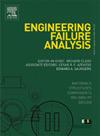Experimental and numerical study on impact resistance of external prestressed reinforced concrete beams
IF 4.4
2区 工程技术
Q1 ENGINEERING, MECHANICAL
引用次数: 0
Abstract
Externally prestressed reinforced concrete (RC) beams demonstrate considerable potential for enhanced structural performance under impact loading. However, a comprehensive understanding of how key factors such as initial prestress, partial prestressing ratio (PPR), and reinforcement ratio influence the failure modes and structural response of these beams under impact loading remains limited. Drop hammer impact tests were performed on externally prestressed concrete beams subjected to varying levels of initial prestress. The influence of initial prestress on the dynamic response and failure modes was assessed through measurements of impact force, support force, and mid-span displacement. The commercial finite element software LS-DYNA was utilized to investigate the effects of key parameters, including initial prestress, partial prestressing ratio, and non-prestressed longitudinal reinforcement ratio, on the impact resistance of externally prestressed beams. Empirical relationships were established via curve fitting based on simulation results. Experimental findings indicate that, under identical impact conditions, higher initial prestress leads to greater peak impact forces and reduced mid-span displacements. As the initial prestress increases, the dominant failure mode shifts from flexural-shear to shear failure. Numerical simulations further demonstrate that mid-span displacement decreases progressively with increases in initial prestress, PPR, or non-prestressed longitudinal reinforcement ratio. Among these, the displacement reduction effect of the non-prestressed longitudinal reinforcement ratio diminishes most rapidly, followed by initial prestress, while the effect of PPR attenuates at the slowest rate.
外预应力钢筋混凝土梁抗冲击性能试验与数值研究
外部预应力钢筋混凝土(RC)梁在冲击荷载下表现出相当大的增强结构性能的潜力。然而,对初始预应力、局部预应力比(PPR)和配筋率等关键因素如何影响这些梁在冲击荷载下的破坏模式和结构响应的全面理解仍然有限。跌落锤冲击试验进行了外部预应力混凝土梁受到不同水平的初始预应力。通过测量冲击力、支撑力和跨中位移来评估初始预应力对动态响应和破坏模式的影响。利用LS-DYNA商用有限元软件,研究初始预应力、局部预应力比、非预应力纵向配筋比等关键参数对外预应力梁抗冲击性能的影响。在仿真结果的基础上,通过曲线拟合建立经验关系。试验结果表明,在相同的冲击条件下,初始预应力越高,峰值冲击力越大,跨中位移越小。随着初始预应力的增大,主要破坏模式由弯剪破坏向剪切破坏转变。数值模拟进一步表明,随着初始预应力、PPR和非预应力纵向配筋比的增加,跨中位移逐渐减小。其中,纵向无预应力配筋率的减位移效果衰减最快,其次是初始预应力,而PPR的减位移效果衰减最慢。
本文章由计算机程序翻译,如有差异,请以英文原文为准。
求助全文
约1分钟内获得全文
求助全文
来源期刊

Engineering Failure Analysis
工程技术-材料科学:表征与测试
CiteScore
7.70
自引率
20.00%
发文量
956
审稿时长
47 days
期刊介绍:
Engineering Failure Analysis publishes research papers describing the analysis of engineering failures and related studies.
Papers relating to the structure, properties and behaviour of engineering materials are encouraged, particularly those which also involve the detailed application of materials parameters to problems in engineering structures, components and design. In addition to the area of materials engineering, the interacting fields of mechanical, manufacturing, aeronautical, civil, chemical, corrosion and design engineering are considered relevant. Activity should be directed at analysing engineering failures and carrying out research to help reduce the incidences of failures and to extend the operating horizons of engineering materials.
Emphasis is placed on the mechanical properties of materials and their behaviour when influenced by structure, process and environment. Metallic, polymeric, ceramic and natural materials are all included and the application of these materials to real engineering situations should be emphasised. The use of a case-study based approach is also encouraged.
Engineering Failure Analysis provides essential reference material and critical feedback into the design process thereby contributing to the prevention of engineering failures in the future. All submissions will be subject to peer review from leading experts in the field.
 求助内容:
求助内容: 应助结果提醒方式:
应助结果提醒方式:


